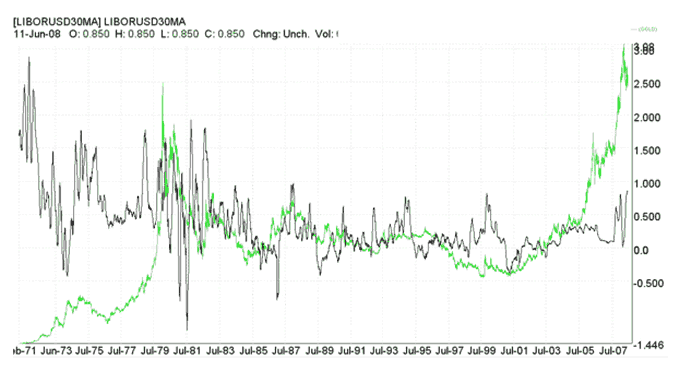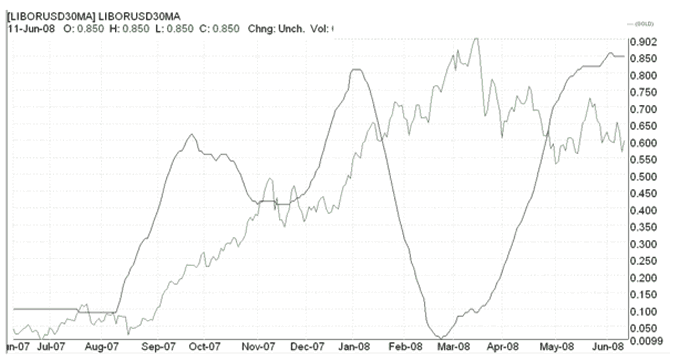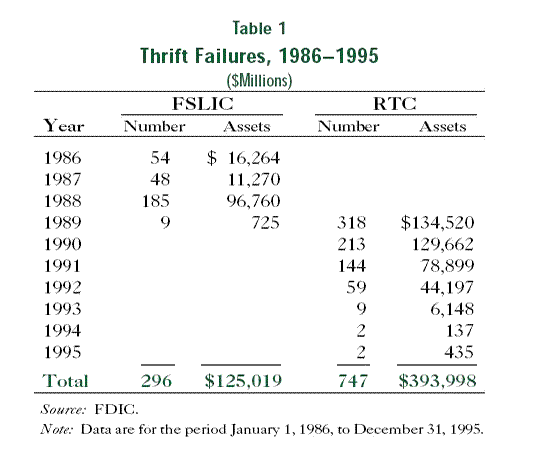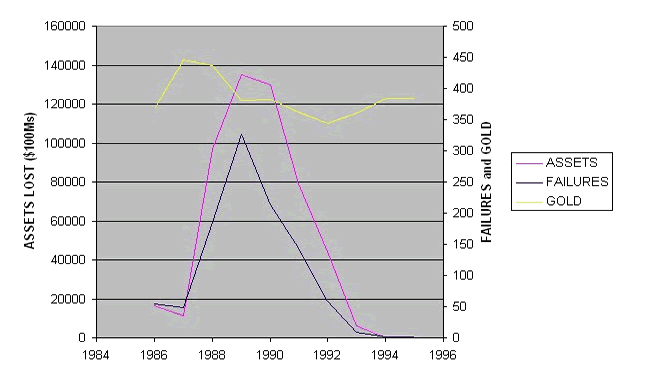Gold and the Credit Crisis
Commodities / Gold & Silver Jul 13, 2008 - 12:07 PM GMTBy: Roland_Watson
 It could not have escaped your attention that the financial sector is undergoing a crisis of confidence just now as the sub-prime loan debacle continues to ripple out to what was once thought as impervious sectors of the banking world.
It could not have escaped your attention that the financial sector is undergoing a crisis of confidence just now as the sub-prime loan debacle continues to ripple out to what was once thought as impervious sectors of the banking world.
Having watched the spectacle of bank runs, bank failures (i.e. takeovers), a falling housing market, increased cost of credit, emergency Fed loans and banks trying to boost capital through rights issues, investors are naturally concerned that even their deposit accounts are under threat. Well so far I am not aware of any major loss of funds by depositors as the Federal Reserve steps in to stabilize the cash flow of vulnerable banks and guarantee the deposits of customers via the FDIC scheme.
That has not stopped gold being recommended as an alternative safe haven to cash as predictions are made that the total write-offs may yet exceed $1 trillion. So is gold a good investment during a credit crunch? How does the price of gold behave during a panic in the financial markets? Let us look at the historical data to come to some conclusions.
First of all, I want to look at the LIBOR rate. This important set of numbers tracks the rate of interest at which banks are prepared to lend to each other. Wikipedia puts is succinctly:
The London Interbank Offered Rate (or LIBOR) is a daily reference rate based on the interest rates at which banks offer to lend unsecured funds to other banks in the London wholesale money market (or interbank market).
The LIBOR consists of various currencies and loan durations to provide a data set that measures the confidence banks have with each other. During financially stable times this rate should not be far from the Federal Funds rate (the rate at which the Fed lends to banks) but in times such as now, the spread widens as banks place a higher premium on lending out money due to uncertainties over the credit worthiness of the bank receiving the loan. It is the spread for 3 month US Dollar rates from 1971 to 2008 that we plot below. To reduce volatility in the display, I have plotted it as a 30 day average to show the general trend in this measurement.
You will also see the daily price of gold superimposed in green on the chart to give an idea as to how the two may be correlated. Now note that a spread close to zero is ideally what one wants to see. However, there have been periods of wild swings where the spread has gone as high as 3% and dropped as low as 1% below the Fed rate. The price of gold meantime seems to have plotted a course which by and large is not highly correlated to the LIBOR spread. Note in the early 1970s how the spread dropped but gold actually rose during the same time period and again when gold blew off to its record high in 1980, the spread was actually less than it had been a few years earlier. The conclusion is that gold was being more influenced by other factors (inflation and the real rate of interest I would suggest).

As we progress in the disinflationary period of the 1980s and 1990s we do tend to notice a degree of correlation between the LIBOR-FFR spread and the price of gold though it is not highly correlated. Moreover, the steep rise in gold in recent years despite the spread being no higher than anything in the prior twenty years leads one to conclude that confidence between banks is not a major factor driving the price of gold. In fact, if we zoom in on the LIBOR spread and the price of gold in this last tumultuous banking year, we get a clearer picture.

We can see here how the LIBOR spread bumped along happily at 0.10 before things exploded with the closure of Bear Stearns' sub-prime hedge funds in August 2007. The panic took off again in March when Stearns was taken over by JP Morgan. The spread reflects the headline stories but gold is not quite reacting in a sympathetic manner. When the spread took off in August, so did gold but gold kept on going once the spread settled down to normal levels. Yet when the major news of the Bear Stearns bankruptcy broke (that's what it was even if they did not file for it), gold headed south and has stayed south ever since despite the spread rising again to new highs for this crisis.
So the matter is at best inconclusive as regards gold and bank failures, but what can we learn from other periods of bank troubles? The two other periods were the Savings and Loans Crisis of the late 1980s and the bank runs of the 1930s. Considering the latter first, over 4,000 banks alone failed in 1933 with a combined loss of nearly $4 billion in the money of that time. That run on the banks led to depositors withdrawing their money in gold coin. However, it was not the case that people were exchanging their money for gold because gold was money back then. A single $20 coin contained nearly one ounce of gold and it was perfectly legal to exchange paper dollars for gold dollars. During this period the price of gold did not budge a cent because the price was fixed at $20.67 per ounce by the US government.
The price was finally raised to $33.11 an ounce in April 1933 but that was only after nearly all gold coin had been confiscated by the Roosevelt administration. As a footnote, the FDIC insurance company was set up after this to guarantee deposits of an insolvent bank and all our miserable depositors received 85% of their money back (albeit many months later).
A better picture is gained during the S&L crisis when the price of gold was left to float freely and not be set by government decree. The bankruptcy of hundreds of savings and loans companies between 1986 and 1995 threatened the savings of millions of depositors as shown in the table below. In total, $394 billion had to be rescued by the government's FSLIC and RTC agencies (parallel institutions to the FDIC). In today's money this amount would be roughly equivalent to an astounding $886 billion. In other words, the S&L crisis was of almost equal proportion to the current sub-prime debacle. How did gold react to this similar crisis?

The crisis reached its peak both in terms of dollars under threat and number of failed companies in 1989. A look at the long term chart above shows that gold in no way spiked during that period. In fact, gold was halfway through a decline starting from 1987 to 1993. One could argue there was a mini-spike in 1989 but it only constituted a rally within a larger downtrend. The graph below confirms this and plots the S&L insolvencies and asset losses against the average price of gold for each year. Notice how gold (yellow line) actually peaked a year before the height of the S&L panic; evidently people were not fleeing to gold during that troublesome period.

In fact, in theory gold should not be expected to track such events. The main reason is because bank failures are essentially deflationary events because money is destroyed. If government steps in to guarantee deposits, it is essentially a zero sum game as far as inflation-deflation is concerned. Yes, I know some argue that gold goes up in a deflation but note that gold could not even stay up during the milder disinflation of the 1980s and 1990s.
No, there is only one main reason why people should hold gold and that is inflation. We have it and it is here to stay for a long time. That is why the price of gold is going up and I submit that this has a lot more to do with the price of gold than any number of bank worries we have seen.
By Roland Watson
http://silveranalyst.blogspot.com
Further analysis of the SLI indicator and more can be obtained by going to our silver blog at http://silveranalyst.blogspot.com where readers can obtain the first issue of The Silver Analyst free and learn about subscription details. Comments and questions are also invited via email to silveranalysis@yahoo.co.uk .
Roland Watson Archive |
© 2005-2022 http://www.MarketOracle.co.uk - The Market Oracle is a FREE Daily Financial Markets Analysis & Forecasting online publication.



